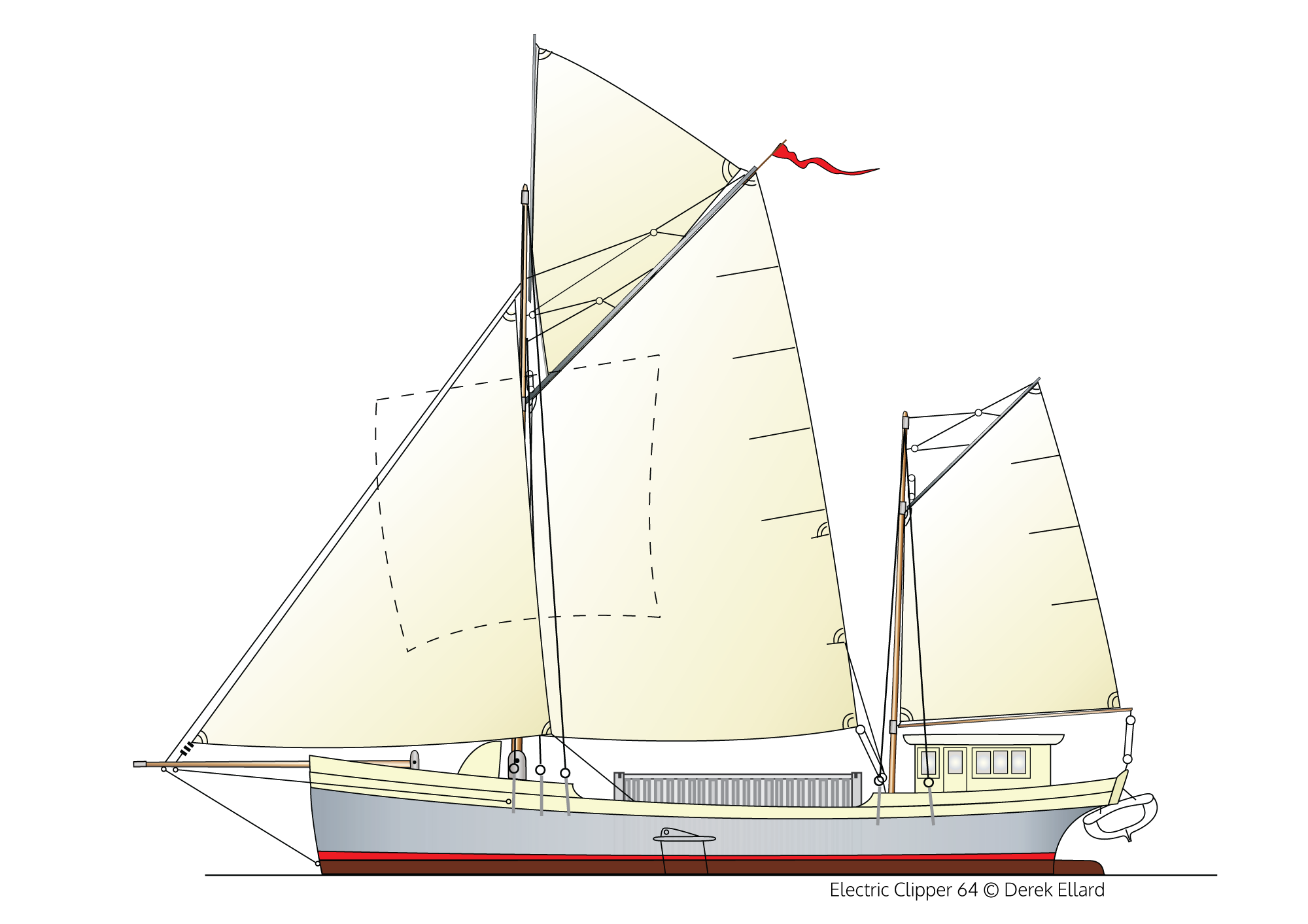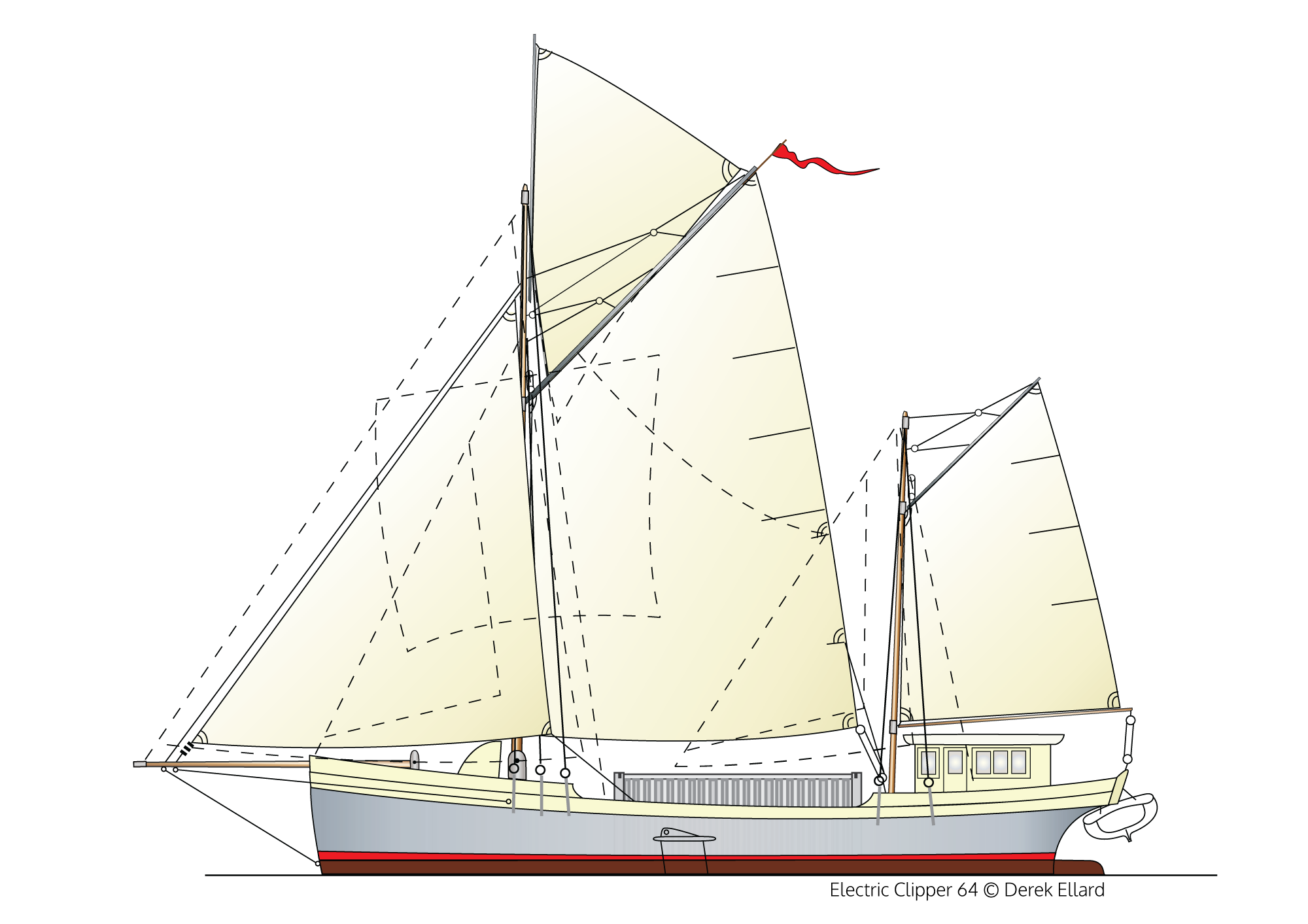ELECTRIC CLIPPER 64
— A tough one-container sailing cargo passenger ship for zero emission trading, custom designed for the job.
— An efficient, easily handled yet powerful ketch rig.
— A crew of 2 + 2 passengers
— A powerful 40kW electric motor with lithium battery banks.
— Solar and propeller charging with back up diesel generator for safety.
— Separate passenger accommodation for two with their own galley, head, and shower.
— Shallow 1.6-metre draught to go where few other cargo boats dare.
— A flat bottom with bilge keels to take the ground safely.
— Wonderfully versatile cargo options from a 20-foot container to stacked pallets to container-sized accommodation units – passenger modules or pretty much anything.
— Gaff crane on board to load and unload up to one tonne each swing.
— Every component of the vessel is designed for a long, low maintenance lifespan.
— A five-passenger sailing dinghy with one pallet capacity and electric auxiliary is stowed in davits.
Click the arrows below to view working sails or full sails
Our Electric Clipper 64 follows on from the Electric Clipper 100 and incorporates the essential design principles established in that ship. Briefly, we sought to create a tough, efficient and cost effective sailing ship that drew on time honoured working rigs yet embraced new but tried and tested technology such as carbonfibre spars. We opted for a steel hull as it is clearly the best option for a small cargo ship and can be repaired pretty much anywhere. We took great care with the hull lines though – the 64 may be a bit barge like but it shouldn’t have to be slow or cumbersome – it isn’t. While considerably smaller than the Electric Clipper 100, the 64 is just as capable and just as versatile. Various cargo/passenger combinations are available including the new “bus” modules.
THE “BUS” MODULE
The bus module systems enable up to 26 passengers to be safely transported in a 20-foot container-sized module. This unit is fabricated in aluminium and is fitted in the hold over removable steel joists. The unit is craned on to the wharf and up to 10 pallets of cargo are then stowed. The steel joists are fitted and the passenger module craned back on board and secured. Passengers can then be embarked and excess luggage is stowed in front of the unit. More luggage or freight is stowed under the side decks. Up to 6 extra passengers can be seated in the passenger cabin below where there is a head, a shower, and a galley.
THE SAILS
THE LOOSE FOOTED MAIN
The 64 incorporates a loose footed mainsail with a brailing line. This sail has its roots in UK work boats such as Thames Barges and Bawleys. On the 64 an extra long gaff in carbonfibre is used. The spar has integral tracks to take an electric pulley with a one-tonne capacity. The main is sheeted in barge style, on to a full-width traveller. Vangs – separate “sheets” to the gaff are rigged to control the spar and sail shape. A carbonfibre whisker pole is also used on longer downwind fetches. This useful spar can also be set to windward for the jib.
A brailing line is fitted to instantly gather up the sail to de-power the rig.
THE “HAMMOCK”
New to sailing is a revolutionary downwind sail we call the “hammock”. It’s a completely new kind of squaresail, set from the bowsprit end using the genoa halyard. The sail features a carbonfibre “boom” at the foot, controlled by two braces. The sail is a full cut spinnaker with an extra wide peak, hanked to the outer forestay. A brailing line is used to gather up the sail when setting or taking in.
THE MIZZEN STAYSAIL
As with the Electric Clipper 100, the mizzen staysail tack is shackled either side of the cargo hold coaming. This sail can be centred over the cargo using a bridle for upwind work.
THE MIZZEN
The mizzen itself has electric roller furling with quick release mast hoop attachments and a winch handle in case of power failure.
THE TOPSAIL
I have drawn in what is technically a yard topsail. Once up there the main can still be quickly depowered and when working rivers the topsail is often the only one drawing efficiently.
THE MASTS
Both ships feature lowering masts secured in tabernacles for shooting low bridges. This facility dramatically increases their ability to reach upriver destinations.
THE CREW
The Electric Clipper 64 is designed to be manned by a crew of 2 or 3, just as the (larger) Thames Barges were but 2 passengers are quartered in the fo'c'sle to help sail the ship on longer voyages.
THE SHIP’S BOAT
Both ships have a new ship’s boat. This one is a new GRP version of our best selling Shimmy 12. The boat will take 5 (or 6 at a pinch) and features a shallower keel with an integral centreboard for windward work under sail.
The Shimmy II has a simple yet effective standing lug rig and will be rowed or carry a 2HP electric outboard. Even the ship’s boat is zero emission, the batteries are plugged in to the ship’s generating system.
SPECIFICATIONS
and square topsail. Both masts lower
**subject to cargo volume
or passenger “bus” module 26 + (6 below) + 10 pallets
*subject to regional variance
and general cargo to 30 tonnes
"When the wind of change blows, some build walls, others build windmills."
— Chinese proverb
"We build sailing ships."
— Go Sail Cargo

